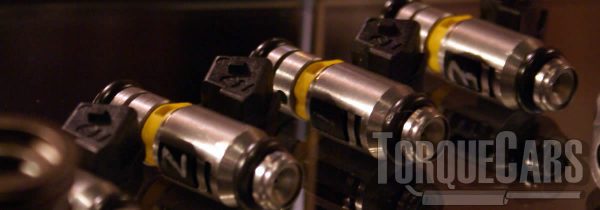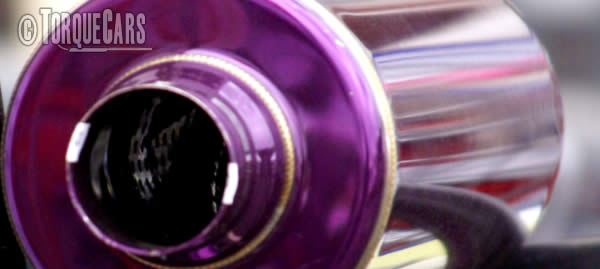Tuning the Rover 75
"Thank you for reading our Rover 75 tuning guide."
The 75 is a great car modification project to execute. If you do your research then you can create an awesome 75 but don't be fooled there are lots of uprated modifications out there that will simply not suit it read our unbiased guides first.
Here we review and look at 75 tuning and report on the best upgrades. Rover 75 great bases for a tuning project and with the right uprated tuning mods like remaps, turbo upgrades and camshafts you will positively enhance your driving fun.

Handling/Suspension upgrades
Handling modifications are a good place to start for the 75.
Good suspension tweaks that usually improve handling for the 75 include a couple of degrees negative camber and 1-1.5 degrees of toe (set out to improve cornering or in for better stability) on the front wheels.
Drop the car by as much as 29mm - 41 mm. and fit sports stiffer dampers, bigger drops will need other modifications in most instances.
For dramatically improved braking put better performance pads and combine this with larger brake discs.
Note that some performance brake pads will be noisy and will have to be hot before they start to work.
On a road car the brakes are only applied now and then , therefore won't be all that effective so source brake pads which have a low working temperature.
Top end power should be your overall aim with a nice fat wide peak torque band.
The best power gains come from larger engine sizes. The more you start with the bigger the return on investment so engine swaps are good value mods for small engined cars.
Engine Tuning.
Typically these modified upgrades are usually carried out by our members, decide how far you want to go before you get going.
Petrol
- 1.8 i4 18K4F
- 1.8 T I4 18K4T
- 2.0 V6 20K4N
- 2.5 V6 25K4N
- 4.6 V8 2L2E
Diesel
- 2.0 I4 M47R
Getting the correct grade of sports upgrade kits for your planned usage of the car is a time and money saver. Stage 3 (competition) mods just won't work well on the road hard to control in slow traffic.
Please watch our introduction Video tutorial to car tuning. Be sure to subscribe and support our new channel.
How to tune your car
- Improve the handling
Focus on Suspension improvements, such as coilovers and make sure the bushings are in good order and that the alignment is correct. Then focus on improving the brakes, with a big disk brake conversion kit and fast road brake pads.
- Remove restrictions
Focus on the intake and exhaust with filters being the common point of restriction in a tuned car. Intercoolers may also become restrictive on turbo engines so this may also need to be uprated.
- Burn more fuel & air
Increase the fuelling so it matches the air coming into the engine. The ratio is important so you need to improve the fuel pump and injectors, so the head mods, big valve conversions, fast road camshafts and forced induction upgrades extra supply of air is adequately met.
- Test and replace any weak parts
Weak areas are commonly the clutch, the turbocharger and pistons and crankshaft in a highly tuned engine. Makes sure these components will cope with your power aspirations.
- The Tune or Remap
A cars ECU controls the fuel, timing, spark and even the turbo in some cases, so to fully extract your gains you should remap the car last and this will fully release the power. Some cars are easy to map, and others require piggyback ECU's or aftermarket ECU's but this is the most vital step of your tuning project.
Modifying to Stage 1:
Suspension upgrade (drop 29mm - 41 mm.), Lighter flywheel, Panel air filter, Remap, Sports exhaust, Alloy wheels.
Modifying to Stage 2:
fuel pump upgrades, Fast road cam, high flow fuel injector, Ported and polished head, Power/Sport clutch.
Modifying to Stage 3:
Sports gearbox, Internal engine upgrades (pistons/head/valves), Engine balancing, Competition cam, Adding or upgrading forced induction (turbo/supercharger).
You really need to keep as much low end power as possible and aim to get a wide power band rather than a narrow top end power spike.
The point of our advice is to give a little insight into the world of customizing mods and point you in the right direction, our forum is where you can ask for more detailed advice and tips on your tuning project, the best tuning modifications and all aspects of modding cars.One of the best mechanical modified modifications you can do to your NASP engine is to fit a fast road camshaft .
It maximises the intake and exhaust durations and pushes up the power if done right. Ideally you'd add other mods and finish up with a reflashed ECU. TorqueCars would caution you not to go with a motor sport cam as this upsets the engines idling and general town driving characteristics.
You will need to ensure that the engine is not starved of fuel so will need to look at the fuelling.
Using high octane fuel is another option if you find you are suffering from detonation or premature ignition on your Rover project after fitting other sports kits.  To get sufficient fuel you may need to uprate the injectors on your engine.
To get sufficient fuel you may need to uprate the injectors on your engine.
A fuel pump will only deliver a finite amount of fuel, so you may need to uprate this if your injectors are demanding more fuel.
Intake and Exhaust Tuning.
Now we move on to the intake and exhaust and ensure proper flow through the engine.  Contrary to popular belief there is usually very little power gain obtained by fitting an induction kit, they only help and are recommended after you increase the engines power to the point where the standard air intake box cannot cope!
Contrary to popular belief there is usually very little power gain obtained by fitting an induction kit, they only help and are recommended after you increase the engines power to the point where the standard air intake box cannot cope!

Maximum power gains come from a full induction kit with a cold air feed on heavily tuned engines, this can be sited within an air box but a performance panel filter should suffice for most applications. TorqueCars suggest you use a panel air filter as these are easy to clean and maintain and generally perform better than paper ones.
Sports exhausts can help balance the flow of gases through the engine. But if the exhaust is too big, ie: over 2.5 inches bore, you will lose a lot of your flow rate and end up sapping power and torque.
Head work including a head port and polished and 3 or 5 angle valve job will really help to release the potential of the engine. A good multi plate fast road performance clutch will help to keep that power going where it should. Never make false economies or expect your standard OEM clutch to cope. The best mods we would do for your 75 are Remapping or piggy back ecu, fast road cam and air intake and exhaust.
Turbo engines are just pleading to be Upgraded. You will see phenomenal power gains on most modern turbo charged cars including diesels making a remap one of the most cost effective and phenomenal modifications for your money.Despite the large cost involved adding forced induction to a NASP engine will give large power gains. It is generally easier to bolt on a supercharger than it is to get a turbo working. It is difficult to map fuelling with a turbo as the boost builds exponentially with revs.
Superchargers however will give a boost which is directly proportional to engine speed so is easier to map. Adding forced induction will usually require a lower compression ratio or water injection.
Alloy wheel upgrades.
Because alloys are lighter they improve performance and they help to cool the brake disks. Don't forget that your choice of rubber greatly affects your cars grip and handling. It is not worth compromising performance with cheap tyres when you can buy directional tread pattern performance tires.Large 75 alloy wheels can decrease performance. If you get big alloy wheels you will be changing your final drive ratio.
Due to this we would advise sticking to a maximum wheel size of 16 inches, although we know some of our members have installed larger rims with no problems.
For more information on Tuning your car please join us in our friendly forum where you can discuss 75 options in more detail with our 75 owners. It would also be worth reading our unbiased Rover tuning articles to get a full grasp of the benefits and drawbacks of each modification.
Please help us improve these tips by sending us your feedback in the comments box below.
We love to hear what our visitors have got up to and which mods work best for them on each model of car. Comments are used to improve the accuracy of these articles which are continually updated.
If you liked this page please share it with your friends, drop a link to it in your favourite forum or use the bookmarking options to save it to your social media profile.
Check out TorqueCars new YouTube channel, and see their awesome new content...
Feedback
Please use our forums if you wish to ask a tuning question, and please note we do not sell parts or services, we are just an online magazine.
Help us improve, leave a suggestion or tip
